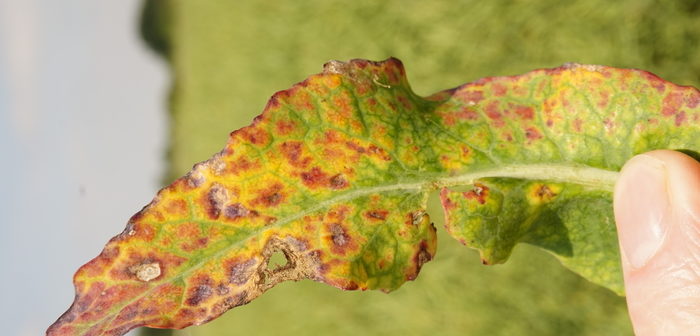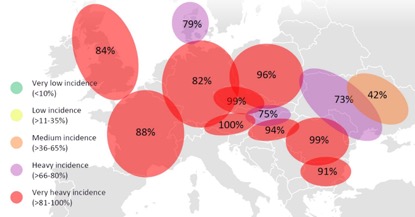Turnip yellows virus (TuYV) is endemic across oilseed rape crops in the UK and growers should be aware of the high risk this autumn as a result of current high aphid numbers, warns plant breeders Limagrain UK.
Turnips yellows virus (TuYV) is transmitted by aphids and it is believed that 70% of the most common aphid, peach potato aphids (Myzus persicae) carry it. Work carried out at Brooms Barn a decade ago, showed a 30% yield penalty where levels of the virus were high and infection occurred early in the crop’s life.
Recent data from Brooms Barn confirms just how high recent aphid pressure is; the Brooms Barn long term average of accumulated catches of Myzus persicae up to 21st of June normally runs to just under 500 aphids caught in their traps. For 2020 this was running at 4400, nearly a tenfold increase. Some plants that were being monitored had 50-100 aphids per plant.
AHDB aphids news tells a very similar story; in the report until the end of June, Alex Greenslade of the Rothamsted Insect survey team, reported that average air temperatures continued to exceed the long-term average. “Coinciding with this, the total cereal aphid numbers increased to around 120% of the last period,” he said.
“Sugar beet is already showing the consequences of this high aphid pressure with many crops exhibiting Virus Yellows symptoms. As aphids start flying in the spring they tend to head for sugar beet first, and then as oilseed rape crops are drilled in the autumn they move across into these,” says Dr Vasilis Gegas, EU portfolio manager for oilseed rape at Limagrain.
“The link between high numbers of aphids in the autumn and corresponding levels of infection is clear.”
“Infection usually occurs in September to October when aphids are still flying; the earlier a crop is infected, the more severe the symptoms tend to be with harsher yield penalty as the plants have less seeds/pods .”
“Early drilled crops that are more open, corresponding with mild autumnal conditions, are at the highest risk,” he adds.
“As control of aphids has become increasingly difficult, so numbers have increased, with a subsequent build up of TuYV inoculum in the environment.”
“Once an aphid is infected, it is infected for life – if an uninfected aphid feeds on an infected plant, the aphid becomes infected and so the cycle continues.”
“Infected plants produce fewer side branches, pods, and seeds per pod. It’s confined to the phloem, so potentially robs the plant of resources that would be fed to the roots.
“But you often don’t see severe symptoms, which is why TuYV often goes undetected. Today’s challenge is that it has become increasingly difficult to control early infection with the loss of neonicotinoid seed treatments, and getting the timings right for spray’s is very difficult.”
“Genetic resistance is by far the best way forward.”
What are TuYV levels now?
Since 2016, Limagrain UK along with industry partners – Agrii, Openfield and the AICC – have been monitoring levels of TuYV in crops across the UK. It’s part of a programme carried out across Europe, with leaf samples taken both in the spring and autumn and tested using the standard Elisa test.
“We’ve mapped the incidence of TuYV from the UK to Ukraine and seen it build over the years,” notes Vasilis. “We’re getting to a situation where in some locations 100% of crops carry the virus. It’s now endemic across Europe, and no longer confined to hotspots.”
Sampling is carried out twice during the growing season, with an initial small-scale survey conducted in Oct-Nov, followed by extensive testing carried out in early spring. “The last couple of seasons we have found very high levels of infection in UK crops in the autumn, which wasn’t the case before.”
“TuYV incidence reached its highest level ever last season, with an average of 84% of non-TuYV resistant UK crops infected in early spring 2019. Almost all sites had an infection rate between 81-100%.”
Source: Internal analysis, Limagrain Europe Laboratory, 2019; TuYV incidence in non-resistant varieties per country, 430 locations.While incidence was highest in East Anglia and south east England, sites in Scotland and the South West now show high levels of infection. “Four years ago we wouldn’t have seen high levels in the North. But last year we saw 70-75% infection of OSR in Perth and 50-54% in Aberdeen,” he points out.
So what role can genetics play?
The value of genetic resistance to TuYV has been well proven since Limagrain launched its first variety Amalie back in 1995. Initially the genetic resistance came with a yield lag, but innovative breeding has overcome this and today, the highest yielding varieties on the AHDB Recommended List all carry TuYV resistance.
This was confirmed in 2019 trials results conducted by the Association of Independent Crop Consultants (AICC) in West Wittering, showed that there was around a 0.4-0.5t/ha yield advantage from varieties with TuYV resistance against those with none.
“Limagrain’s conventional Aspire, performed very well yielding 6.7t/ha; that’s a significant yield jump over the 6t/ha from the non-TuYV resistant variety; Campus. Aurelia was just behind, yielding 6.4t/ha,” explains Peter Cowlrick, director in CCC Agronomy Ltd, who managed the trials.
In Suffolk, the trend was the same, with TuYV resistant varieties leading the pack. Aurelia managed a top yield of 6.1t/ha, well above that of Campus at just above 5.6t/ha. Ambassador yielded just below 5.9t/ha and Aspire 5.86t/ha.
“These varieties also play an important role in IPM, as there is less reliance on insecticides which are challenging to time correctly, especially near the coast, and in a crop where the canopy has grown up well and provides its own microclimate for aphids to continue reproducing, “ says Mr Cowlrick.
““In the south-east, where the risk of TuYV infection is very high, on some farms almost 80% of the crop going into the ground this autumn will be TuYV resistant varieties. There’s such a strong argument for growing a TuYV-resistant variety, why wouldn’t you?”
Limagrain’s top yielding varieties all carry TuYV resistance:
| Ambassador | Aurelia | Artemis | Aspire | |
| Variety type | RH | RH | RH | Conv |
| UK Gross output (% treated control) | 108 | 108 | 107 | 106 |
| Oil content (%) | 45.3 | 45.2 | 45.7 | 45.7 |
| Stem stiffness | 8 | 8 | 8 | 9 |
| Shortness of stem | 6 | 6 | 5 | 7 |





